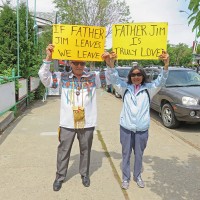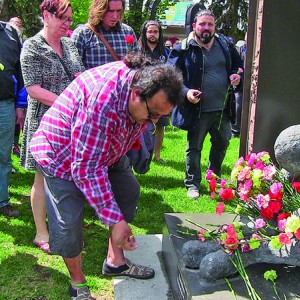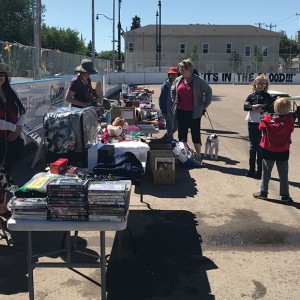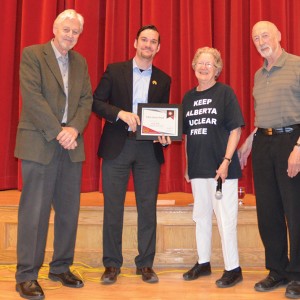Father Jim Holland Leaving Sacred Heart
Priest and community leader has served the area for 22 years.

The May 21, 2017, Sunday Mass at Sacred Heart Church of the First Peoples included a special announcement by Father James L. Holland, OMI. He will begin a sabbatical year on September 1, 2017, and two new parish priests will be taking over his role at the church, each for a three-year term. Father Susai Jesu speaks Cree and has served Aboriginal parishes in Saskatchewan. Father Tom Kurudeepan has worked with the Mi’kmaq in Nova Scotia for 20 years.
“Fr. Jim,” as this much-loved priest and community leader is commonly known, has served at Sacred Heart for 22 years, since 1995.
Parishioners devastated
Many church members are meeting this news with sadness and dismay. Two years ago the OMI (Missionary Oblates of Mary Immaculate) head office announced a transfer for Fr. Jim, but the community was able to forestall the move by collecting approximately 3000 signatures on a petition.
Elder Gilman Cardinal says, “Now it is happening again, and I am devastated.” When Fr. Jim first arrived at Sacred Heart, a friend invited Cardinal to attend a service there. Cardinal, who is continually impressed by the priest’s “passion and respect,” has been an active member ever since. He says Fr. Jim “brought the Aboriginal people back to church,” noting that the Catholic church has a history of making decisions about how best to serve Indigenous people without consulting them.
Marlene Poitras, who is part of the strong music component of the church services, has begun collecting signatures again, as she did two years ago. “I am not happy,” she says. “Fr. Jim has done so much. I think it is totally disrespectful to boot him out without consulting the church members, as the OMI head office said it would do.”
Before the Sunday mass on May 28, local artist Wayne Ashley spoke passionately about Fr. Jim’s respect for the Aboriginal people and active participation in the broader community. Ashley hopes to organize demonstrations and protests. He asked people to come to the church on Saturday mornings to develop a plan of action.
Fr. Jim repeatedly states in interviews and sermons that the church is the people, not the leaders like him or his superiors. He describes himself as outspoken, and says, “Sometimes people don’t like it when you tell the truth.” At the same time though, he says he is looking forward to having a sabbatical.
Fr. Ken Forster, Provincial of the OMI Lacombe Canada and Fr. Jim’s religious superior, says, “For various reasons, parish priests generally move every six to eight years. There are exceptions to this practice in unique situations such as Sacred Heart, where experience and training in Aboriginal culture and spiritual heritage is required. We try to put the right people in the right place.”
Fr. Jim’s achievements
In addition to introducing a strong Aboriginal cultural component to the church services, Fr. Jim served on many boards of area organizations, and he opened the church to many activities and events related to social justice. He supported those struggling with addiction, homelessness, and the legacy of residential schools. He spoke out in favour of supervised injection sites to deal with the growing opioid crisis in Alberta.
Fr. Jim received the Queen Elizabeth II Golden Jubilee Medal in 2002 and the Capital Region Integrity Award from the Rotary Club of Edmonton in 2007. In 2016, he was given an eagle feather headdress by a Kainai Elder from the Blood reserve in southern Alberta The City of Edmonton’s Naming Committee has given the name Fr. Jim Holland Way to a portion of the avenue outside the church at 10821-96 Street. In October, he will receive the Alberta Order of Excellence.
About Sacred Heart
Sacred Heart Parish has had a tradition of receiving and caring for newcomers throughout its history. Opened in 1913 in what was then the centre of Edmonton, the church served the flood of immigrants to Western Canada. People of all faiths and ethnic origins, many of whom were needy and hungry, were received and helped. A food bank operated out of the church for many years.
The parish became Sacred Heart Church of the First Peoples on October 27, 1991, when Archbishop Joseph MacNeil declared it Edmonton’s First Nations, Métis, and Inuit parish. The interior of this French Gothic Revival church is transformed by original, colourful works of art by Native artists.
People of all backgrounds are welcome to join in worship at the First Nations, Métis, and Inuit Mass on Sunday mornings.
Church Street
Church Street (96 Street from the north bank of the North Saskatchewan River to 111 Avenue) is home to an unusually large number of churches and religious buildings, beginning with the St. Barbara Russian Orthodox Cathedral on the river bank, and including Sacred Heart. The buildings vary considerably in their religious denominations, architectural styles, and the time period when they were constructed. There are also many other churches nearby, for example, St. Josephat Ukrainian Cathedral at 10825 – 97 Street.
Anita Jenkins is a retired writer and editor who moved to Boyle Street three years ago and loves her new community.








